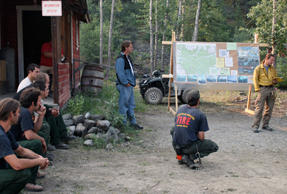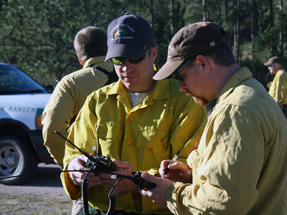This article is part of the Wildland Fire Learning In Depth series. It is designed for students who want to learn more about fire. Find the complete series on the Fire subject site.
Usually shortened to ICS, the Incident Command System is used to manage people and resources during many different types of incidents including fire, rescues, hurricanes, and more.
ICS History
ICS is a system designed to manage any size of wildland fire incident from beginning to end, until the requirement for management no longer exists. As a result of those fires, a need was identified to develop a system whereby different agencies could work together toward a common goal in an effective and efficient manner. The system consists of procedures for controlling personnel, facilities, equipment and communications and is designed to address any type of incident (wildland fire, search & rescue, structural fire, special events, etc.).
The ICS is a system designed to manage any size of incident from its beginning until the requirement for management no longer exists. The Incident Commander is in charge of an incident and is a title that can apply equally to an engine foreman or to the chief of a department depending upon the situation. The structure of the ICS can be established to expand and contract as needed to meet the changing conditions of the incident. It is intended to be staffed and operated by qualified personnel from any emergency services agency and may involve personnel from a variety of agencies.
The ICS Components
These components working together interactively provide the basis for an effective concept of operation:
- Common terminology
- Modular organization
- Integrated communications
- Unified command structure
- Consolidated action plans (Incident Action Plans)
- Manageable span-of-control
- Pre-designated incident facilities
- Comprehensive resource management
The Five ICS Functions
ICS uses five major components that make up most successful organizations. ICS is broken down into the functional areas of:
The Chiefs of Operations, Planning, Logistics, and Finance/Administration are referred to in ICS as the General Staff positions.
When assigned, Operations, Planning, Logistics, and Finance/Administration report directly to Command.
Command
Command is responsible for the overall management of the incident. Command establishes the strategy and tactics for the incident and has the ultimate responsibility for the success of the incident activities. Firefighter safety is the primary responsibility of Command. The Command role is filled by the Incident Commander (IC) and is the position that is established at every incident, no matter how small or large. Command staff includes the Information Officer, Liaison Officer and Safety Officer.
Incident Commander—The Incident Commander’s (IC) responsibility is the overall management of the incident. On most incidents the command activity is carried out by a single Incident Commander. The IC is selected by qualifications and experience. The IC determines incident objective and strategy, sets immediate priorities, establishes an appropriate organization, authorizes an Incident Action Plan, coordinates activity for all Command and General Staff, ensures safety, coordinates with key people and officials, authorizes release of information to the news media and the public, and performs other key duties.
The IC may have a deputy, who may be from the same agency, or from an assisting agency. Deputies may also be used at section and branch levels of the ICS organization. Deputies must have the same qualifications as the person for whom they work and they must be ready to take over that position at any time.

Information Officer—The Information Officer answers directly to the Incident Commander and is responsible for developing and releasing information about the incident to the news media, to local publics, to incident personnel, and to other appropriate agencies and organizations. The IO may have numerous assistants if necessary. The IO organization conducts media briefings, tours, writes news releases, develops information summaries and displays, distributes newspapers to incident personnel, and works closely with other members of the Command and General Staffs.
Liaison Officer —Incidents that are multi-jurisdictional, or have several agencies involved, may require the establishment of the Liaison Officer position on the Command Staff. The Liaison Officer is the contact for the personnel assigned to the incident by assisting or cooperating agencies. These are personnel other than those on direct tactical assignments or those involved in a Unified Command. The Liaison Officer establishes and maintains interagency contacts, keeps agencies supporting the incident aware of incident status, monitors incident operations to identify current or potential organizational problems, and works closely with other members of the Command and General Staffs.
Safety Officer—The Safety Officer’s function is to develop and recommend measures for assuring personnel safety, to assess and/or anticipate hazardous and unsafe situations, exercise authority to stop and prevent unsafe acts, investigate accidents that have occurred with the incident area, and review/approve the incident medical plan.
The command function within the ICS may be conducted in two general ways:
Single command
- When the incident occurs within a single jurisdictional boundary
- Incident commander is solely responsible for establishing objectives and overall management strategy
- May be large enough to have a Deputy IC to share IC duties
Unified Command
- When the incident occurs within a multiple jurisdictional boundaries, or a single jurisdiction with multiple agencies
- Incident is multi-jurisdictional in nature
- Objectives, strategies and priorities are jointly determined
Operations
The function of Operations (Ops) is to accomplish the strategy Command develops by directing the tactical objectives. Operations directs all the incident tactical operations and assists Command in the development of the Incident Action Plan (IAP).
Operations Section Chief—The Operations Section Chief manages incident tactical operations by directly supervising all Operations Branch/Division/Group and Air Operations personnel, develops the operations portion of the Incident Action Plan, requests resources to support tactical operations, maintains close communication with the Incident Commander, and ensures safe tactical operations. The majority of most incident personnel work under the Operations Section - everyone else on the incident supports these "on-the-ground and in-the-air troops."
Planning
The Planning function is to collect and evaluate information that is needed for preparation of the action plan. Planning forecasts the probable course of events the incident may take and prepares alternative strategies for changes in or modifications to the IAP.
Planning Section Chief—The Planning Section Chief supervises the collection, evaluation, processing and dissemination of resource and situational incident information in an Incident Action Plan for use on each incident. The Planning Chief is a member of the General Staff.
There are four units within the Planning Section that can be activated as necessary:
- Resources Unit—check-in and status tracking of all resources/personnel on the incident.
- Situation Unit—collects, organizes and maps all incident intelligence information.
- Documentation Unit—maintains official incident documentation files.
- Demobilization Unit—develops and implements the incident demobilization plan.
Logistics
Logistics can be described as filling the "Supply Sergeant" role for the incident. Logistics provides services and supplies in support of the tactical operations. Included in Logistics' responsibilities are providing for facilities, transportation, supplies, equipment maintenance and fueling, and feeding and medical services for response personnel.
Logistics Section Chief—The Logistics Section Chief supervises all incident support needs, with the exception of aviation support.

Six units may be established within the Logistics Section:
- Supply Unit—orders, receives, processes and stores all support supplies.
- Facilities Unit—sets up, maintains and demobilizes all support facilities.
- Ground Support Unit—maintains, services, all vehicles and provides transport services.
- Communications Unit—tracks and maintains radios, phones, FAX, and PA systems.
- Food Unit—supplies food and water needs for the entire incident.
- Medical Unit—provides medical aid and emergency procedures.
Finance/Administration (F/A)
Usually formally implemented during large-scale incidents, F/A is responsible for the required fiscal documentation needed and produced as a result of the emergency. F/A also provides financial planning and advice to the IC to aid in meeting any fiscal statutory requirements.
Finance/Administration Section Chief—The Finance/Administration Chief supervises all financial aspects of an incident. Not all incidents will require a Finance/Administration Section.
There are four units that may be established within the Finance/Administration Section:
- Time Unit—ensures accurate recording of daily personnel time.
- Procurement Unit—handles vendor contracts, leases, and equipment time records.
- Compensation/Claims Unit—handles compensation-for-injury and property claims.
- Cost Unit—provides all incident cost analysis and maintains records of incident costs.
Part of a series of articles titled Wildland Fire - Learning In Depth.
Last updated: June 1, 2023
